IoT Smart City Technology Challenges: A Comprehensive Report
VerifiedAdded on 2023/06/07
|6
|1626
|231
Report
AI Summary
This report delves into the multifaceted challenges of implementing IoT smart city technology. It categorizes these challenges into vulnerability to attacks, security and privacy concerns, lack of skills in data interpretation, and interoperability issues. The report explores these challenges within the context of key smart city applications, including healthcare, public transport and traffic, and environmental conditions. In healthcare, the report highlights privacy concerns related to the collection and use of personal health data. In public transport, it discusses the security risks associated with monitoring systems, and the potential for criminal misuse. Finally, the report examines how environmental monitoring can lead to increased crime rates. The conclusion emphasizes that, despite the considerable benefits of IoT smart city technology, careful monitoring is essential to mitigate the associated risks, particularly concerning citizen privacy and security.
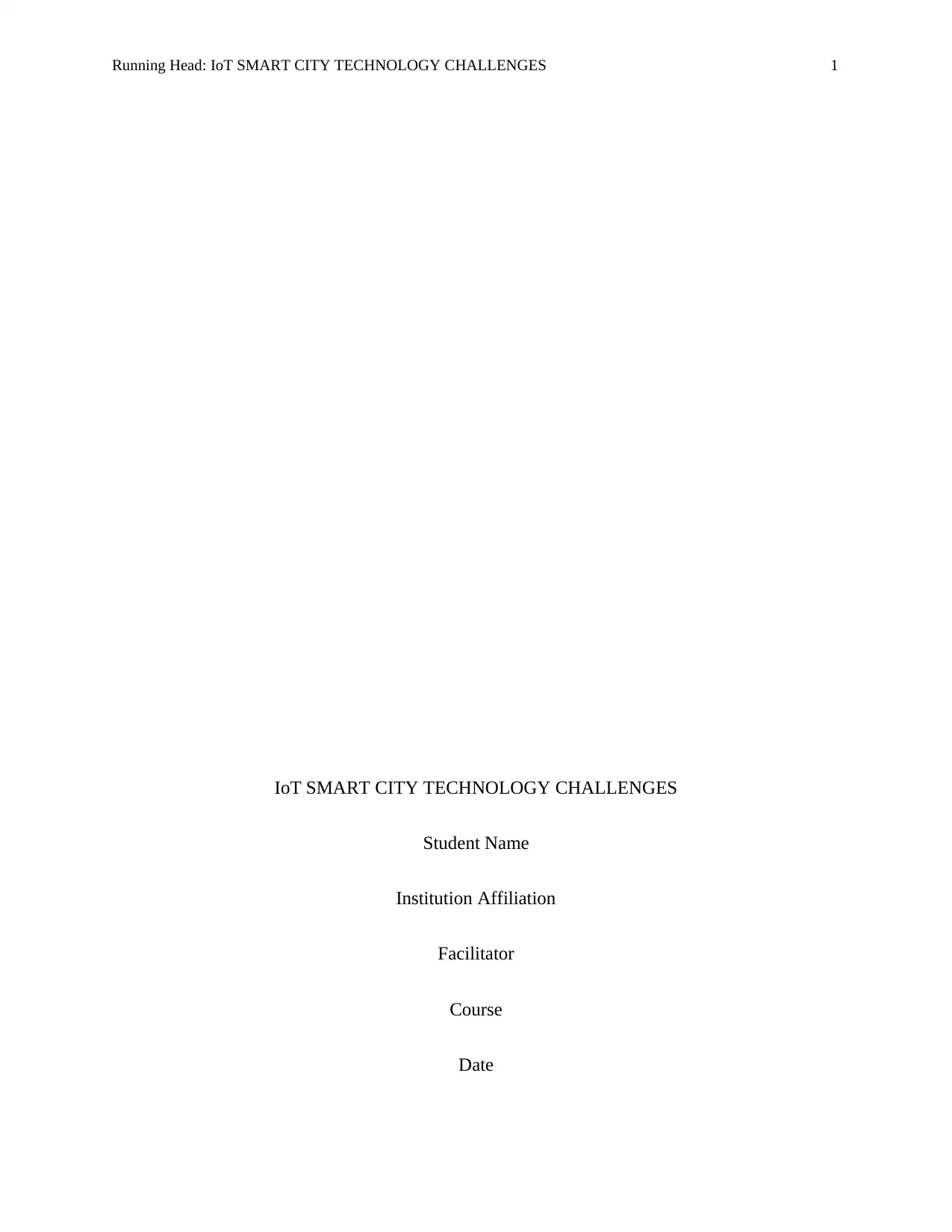
Running Head: IoT SMART CITY TECHNOLOGY CHALLENGES 1
IoT SMART CITY TECHNOLOGY CHALLENGES
Student Name
Institution Affiliation
Facilitator
Course
Date
IoT SMART CITY TECHNOLOGY CHALLENGES
Student Name
Institution Affiliation
Facilitator
Course
Date
Paraphrase This Document
Need a fresh take? Get an instant paraphrase of this document with our AI Paraphraser
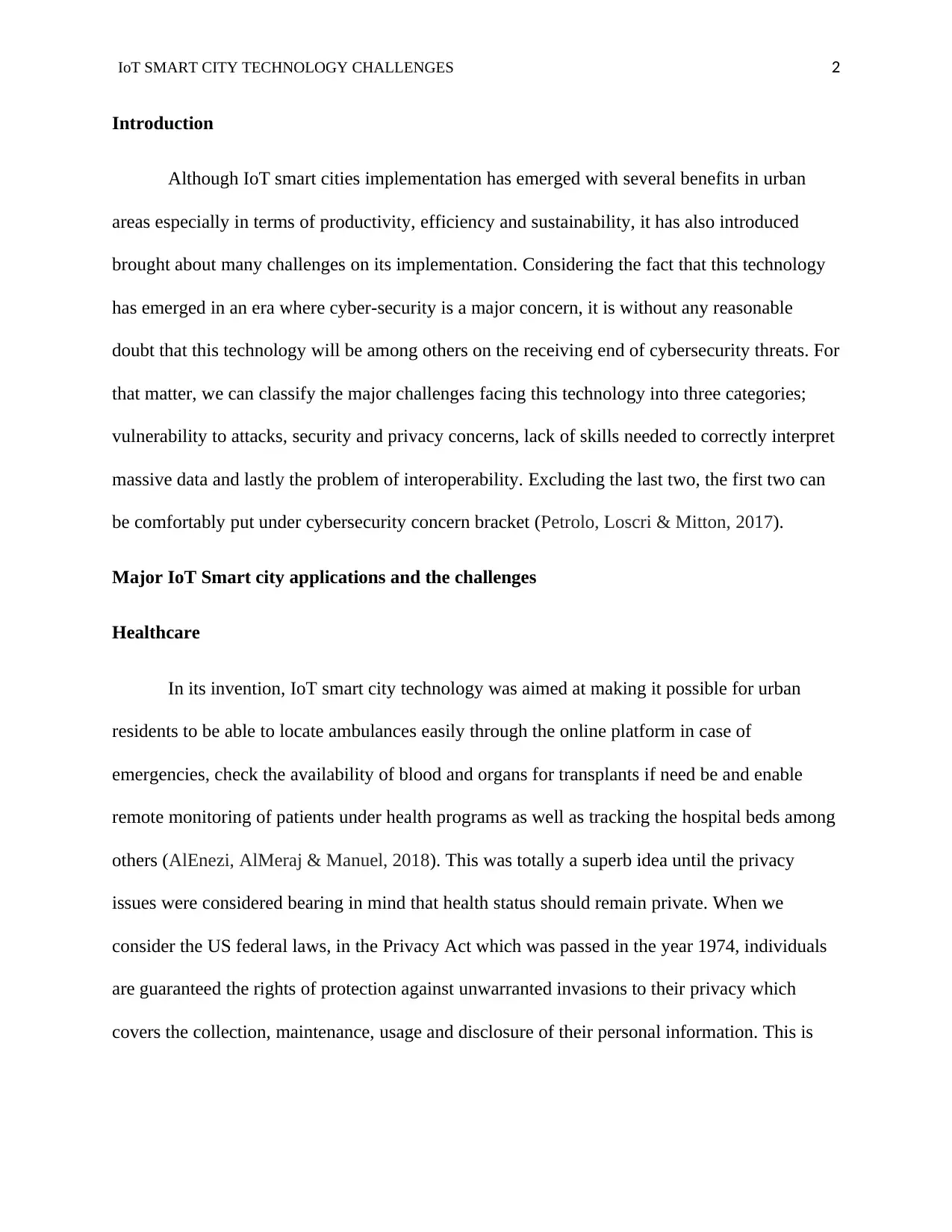
IoT SMART CITY TECHNOLOGY CHALLENGES 2
Introduction
Although IoT smart cities implementation has emerged with several benefits in urban
areas especially in terms of productivity, efficiency and sustainability, it has also introduced
brought about many challenges on its implementation. Considering the fact that this technology
has emerged in an era where cyber-security is a major concern, it is without any reasonable
doubt that this technology will be among others on the receiving end of cybersecurity threats. For
that matter, we can classify the major challenges facing this technology into three categories;
vulnerability to attacks, security and privacy concerns, lack of skills needed to correctly interpret
massive data and lastly the problem of interoperability. Excluding the last two, the first two can
be comfortably put under cybersecurity concern bracket (Petrolo, Loscri & Mitton, 2017).
Major IoT Smart city applications and the challenges
Healthcare
In its invention, IoT smart city technology was aimed at making it possible for urban
residents to be able to locate ambulances easily through the online platform in case of
emergencies, check the availability of blood and organs for transplants if need be and enable
remote monitoring of patients under health programs as well as tracking the hospital beds among
others (AlEnezi, AlMeraj & Manuel, 2018). This was totally a superb idea until the privacy
issues were considered bearing in mind that health status should remain private. When we
consider the US federal laws, in the Privacy Act which was passed in the year 1974, individuals
are guaranteed the rights of protection against unwarranted invasions to their privacy which
covers the collection, maintenance, usage and disclosure of their personal information. This is
Introduction
Although IoT smart cities implementation has emerged with several benefits in urban
areas especially in terms of productivity, efficiency and sustainability, it has also introduced
brought about many challenges on its implementation. Considering the fact that this technology
has emerged in an era where cyber-security is a major concern, it is without any reasonable
doubt that this technology will be among others on the receiving end of cybersecurity threats. For
that matter, we can classify the major challenges facing this technology into three categories;
vulnerability to attacks, security and privacy concerns, lack of skills needed to correctly interpret
massive data and lastly the problem of interoperability. Excluding the last two, the first two can
be comfortably put under cybersecurity concern bracket (Petrolo, Loscri & Mitton, 2017).
Major IoT Smart city applications and the challenges
Healthcare
In its invention, IoT smart city technology was aimed at making it possible for urban
residents to be able to locate ambulances easily through the online platform in case of
emergencies, check the availability of blood and organs for transplants if need be and enable
remote monitoring of patients under health programs as well as tracking the hospital beds among
others (AlEnezi, AlMeraj & Manuel, 2018). This was totally a superb idea until the privacy
issues were considered bearing in mind that health status should remain private. When we
consider the US federal laws, in the Privacy Act which was passed in the year 1974, individuals
are guaranteed the rights of protection against unwarranted invasions to their privacy which
covers the collection, maintenance, usage and disclosure of their personal information. This is
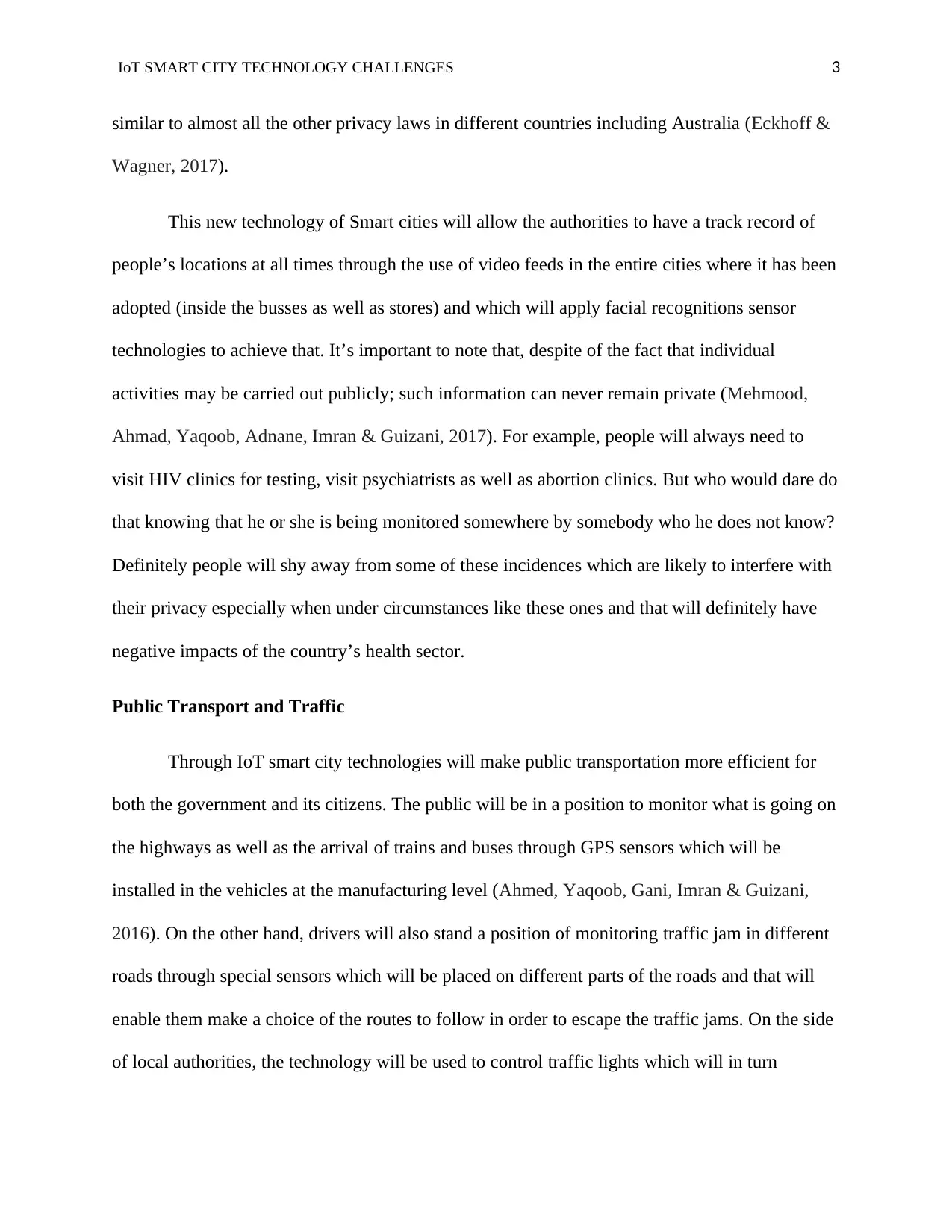
IoT SMART CITY TECHNOLOGY CHALLENGES 3
similar to almost all the other privacy laws in different countries including Australia (Eckhoff &
Wagner, 2017).
This new technology of Smart cities will allow the authorities to have a track record of
people’s locations at all times through the use of video feeds in the entire cities where it has been
adopted (inside the busses as well as stores) and which will apply facial recognitions sensor
technologies to achieve that. It’s important to note that, despite of the fact that individual
activities may be carried out publicly; such information can never remain private (Mehmood,
Ahmad, Yaqoob, Adnane, Imran & Guizani, 2017). For example, people will always need to
visit HIV clinics for testing, visit psychiatrists as well as abortion clinics. But who would dare do
that knowing that he or she is being monitored somewhere by somebody who he does not know?
Definitely people will shy away from some of these incidences which are likely to interfere with
their privacy especially when under circumstances like these ones and that will definitely have
negative impacts of the country’s health sector.
Public Transport and Traffic
Through IoT smart city technologies will make public transportation more efficient for
both the government and its citizens. The public will be in a position to monitor what is going on
the highways as well as the arrival of trains and buses through GPS sensors which will be
installed in the vehicles at the manufacturing level (Ahmed, Yaqoob, Gani, Imran & Guizani,
2016). On the other hand, drivers will also stand a position of monitoring traffic jam in different
roads through special sensors which will be placed on different parts of the roads and that will
enable them make a choice of the routes to follow in order to escape the traffic jams. On the side
of local authorities, the technology will be used to control traffic lights which will in turn
similar to almost all the other privacy laws in different countries including Australia (Eckhoff &
Wagner, 2017).
This new technology of Smart cities will allow the authorities to have a track record of
people’s locations at all times through the use of video feeds in the entire cities where it has been
adopted (inside the busses as well as stores) and which will apply facial recognitions sensor
technologies to achieve that. It’s important to note that, despite of the fact that individual
activities may be carried out publicly; such information can never remain private (Mehmood,
Ahmad, Yaqoob, Adnane, Imran & Guizani, 2017). For example, people will always need to
visit HIV clinics for testing, visit psychiatrists as well as abortion clinics. But who would dare do
that knowing that he or she is being monitored somewhere by somebody who he does not know?
Definitely people will shy away from some of these incidences which are likely to interfere with
their privacy especially when under circumstances like these ones and that will definitely have
negative impacts of the country’s health sector.
Public Transport and Traffic
Through IoT smart city technologies will make public transportation more efficient for
both the government and its citizens. The public will be in a position to monitor what is going on
the highways as well as the arrival of trains and buses through GPS sensors which will be
installed in the vehicles at the manufacturing level (Ahmed, Yaqoob, Gani, Imran & Guizani,
2016). On the other hand, drivers will also stand a position of monitoring traffic jam in different
roads through special sensors which will be placed on different parts of the roads and that will
enable them make a choice of the routes to follow in order to escape the traffic jams. On the side
of local authorities, the technology will be used to control traffic lights which will in turn
⊘ This is a preview!⊘
Do you want full access?
Subscribe today to unlock all pages.

Trusted by 1+ million students worldwide
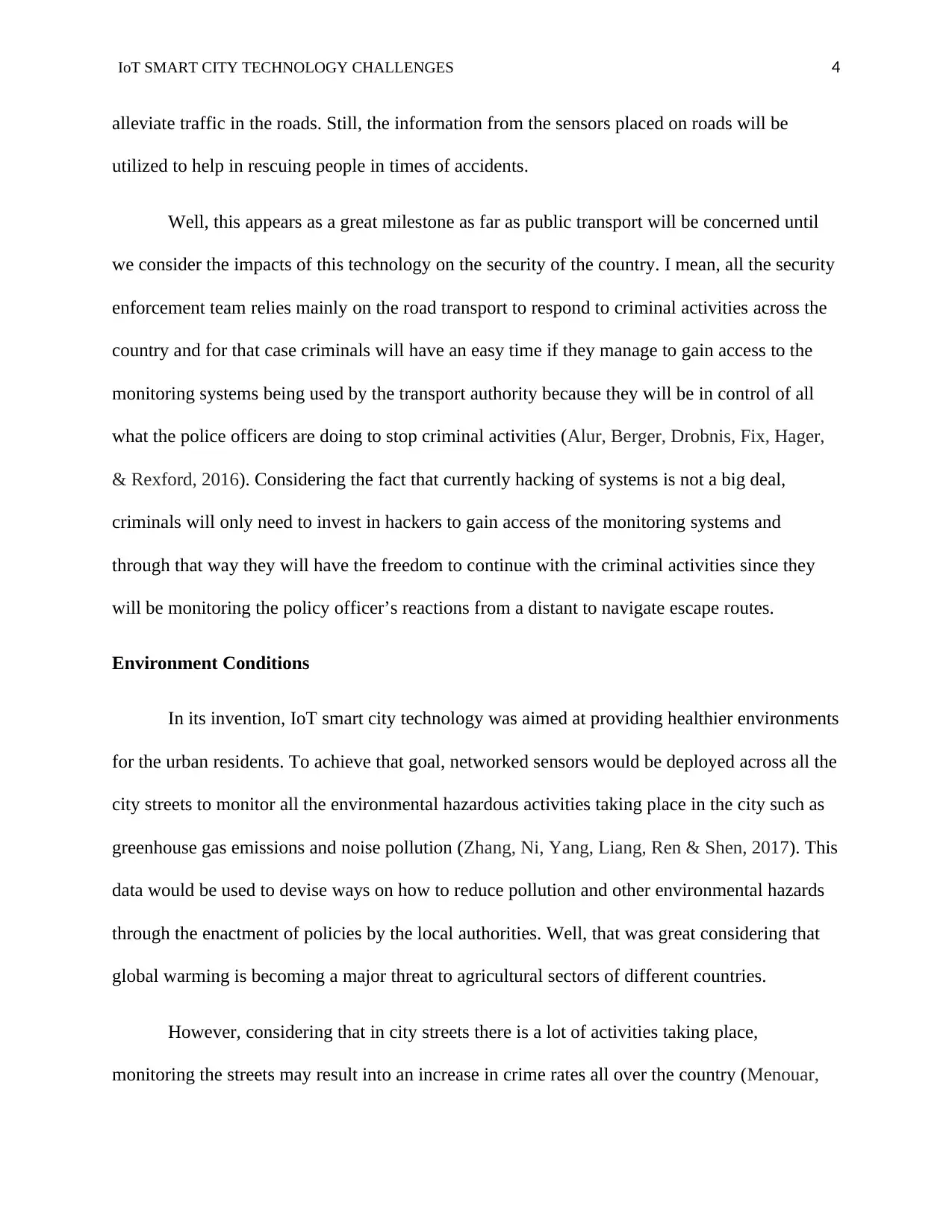
IoT SMART CITY TECHNOLOGY CHALLENGES 4
alleviate traffic in the roads. Still, the information from the sensors placed on roads will be
utilized to help in rescuing people in times of accidents.
Well, this appears as a great milestone as far as public transport will be concerned until
we consider the impacts of this technology on the security of the country. I mean, all the security
enforcement team relies mainly on the road transport to respond to criminal activities across the
country and for that case criminals will have an easy time if they manage to gain access to the
monitoring systems being used by the transport authority because they will be in control of all
what the police officers are doing to stop criminal activities (Alur, Berger, Drobnis, Fix, Hager,
& Rexford, 2016). Considering the fact that currently hacking of systems is not a big deal,
criminals will only need to invest in hackers to gain access of the monitoring systems and
through that way they will have the freedom to continue with the criminal activities since they
will be monitoring the policy officer’s reactions from a distant to navigate escape routes.
Environment Conditions
In its invention, IoT smart city technology was aimed at providing healthier environments
for the urban residents. To achieve that goal, networked sensors would be deployed across all the
city streets to monitor all the environmental hazardous activities taking place in the city such as
greenhouse gas emissions and noise pollution (Zhang, Ni, Yang, Liang, Ren & Shen, 2017). This
data would be used to devise ways on how to reduce pollution and other environmental hazards
through the enactment of policies by the local authorities. Well, that was great considering that
global warming is becoming a major threat to agricultural sectors of different countries.
However, considering that in city streets there is a lot of activities taking place,
monitoring the streets may result into an increase in crime rates all over the country (Menouar,
alleviate traffic in the roads. Still, the information from the sensors placed on roads will be
utilized to help in rescuing people in times of accidents.
Well, this appears as a great milestone as far as public transport will be concerned until
we consider the impacts of this technology on the security of the country. I mean, all the security
enforcement team relies mainly on the road transport to respond to criminal activities across the
country and for that case criminals will have an easy time if they manage to gain access to the
monitoring systems being used by the transport authority because they will be in control of all
what the police officers are doing to stop criminal activities (Alur, Berger, Drobnis, Fix, Hager,
& Rexford, 2016). Considering the fact that currently hacking of systems is not a big deal,
criminals will only need to invest in hackers to gain access of the monitoring systems and
through that way they will have the freedom to continue with the criminal activities since they
will be monitoring the policy officer’s reactions from a distant to navigate escape routes.
Environment Conditions
In its invention, IoT smart city technology was aimed at providing healthier environments
for the urban residents. To achieve that goal, networked sensors would be deployed across all the
city streets to monitor all the environmental hazardous activities taking place in the city such as
greenhouse gas emissions and noise pollution (Zhang, Ni, Yang, Liang, Ren & Shen, 2017). This
data would be used to devise ways on how to reduce pollution and other environmental hazards
through the enactment of policies by the local authorities. Well, that was great considering that
global warming is becoming a major threat to agricultural sectors of different countries.
However, considering that in city streets there is a lot of activities taking place,
monitoring the streets may result into an increase in crime rates all over the country (Menouar,
Paraphrase This Document
Need a fresh take? Get an instant paraphrase of this document with our AI Paraphraser
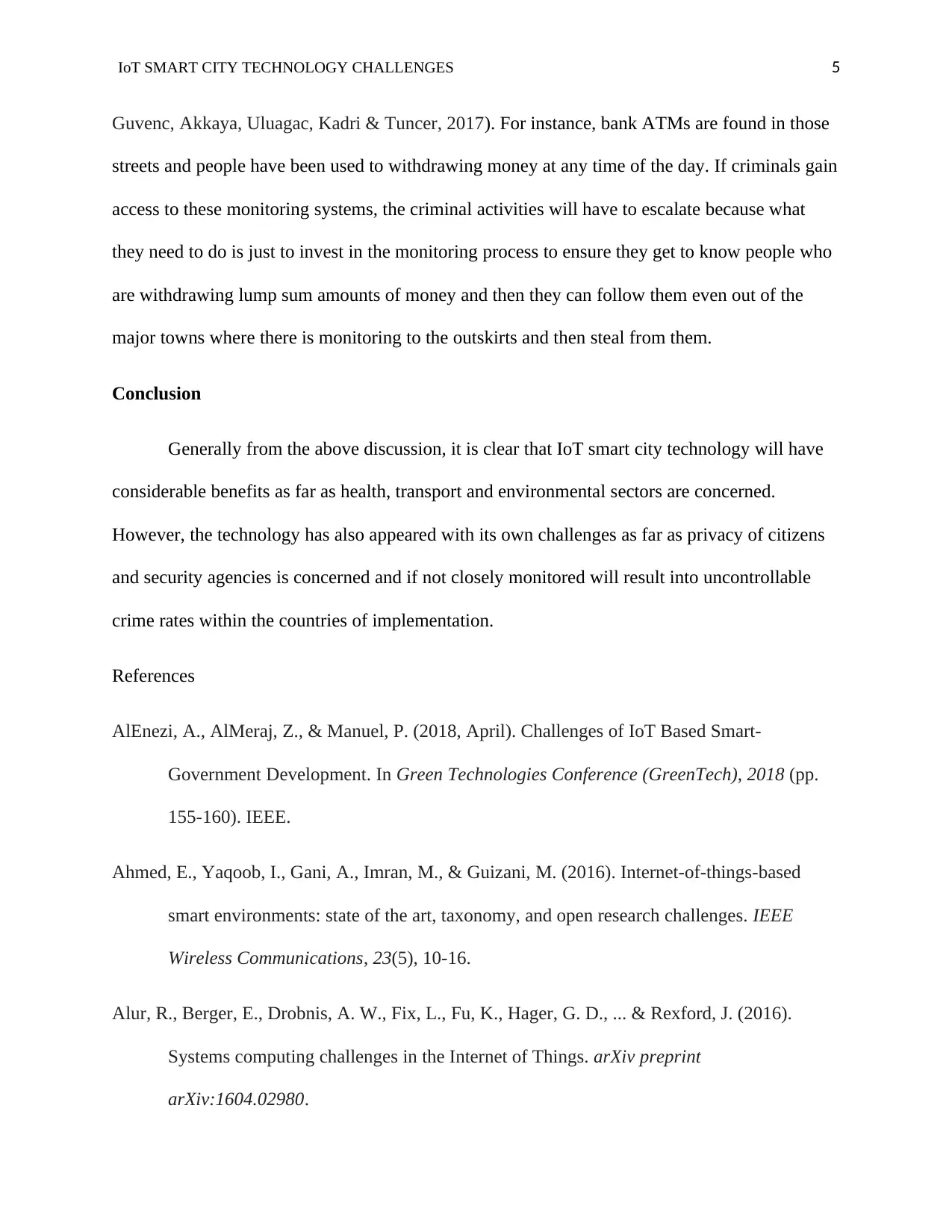
IoT SMART CITY TECHNOLOGY CHALLENGES 5
Guvenc, Akkaya, Uluagac, Kadri & Tuncer, 2017). For instance, bank ATMs are found in those
streets and people have been used to withdrawing money at any time of the day. If criminals gain
access to these monitoring systems, the criminal activities will have to escalate because what
they need to do is just to invest in the monitoring process to ensure they get to know people who
are withdrawing lump sum amounts of money and then they can follow them even out of the
major towns where there is monitoring to the outskirts and then steal from them.
Conclusion
Generally from the above discussion, it is clear that IoT smart city technology will have
considerable benefits as far as health, transport and environmental sectors are concerned.
However, the technology has also appeared with its own challenges as far as privacy of citizens
and security agencies is concerned and if not closely monitored will result into uncontrollable
crime rates within the countries of implementation.
References
AlEnezi, A., AlMeraj, Z., & Manuel, P. (2018, April). Challenges of IoT Based Smart-
Government Development. In Green Technologies Conference (GreenTech), 2018 (pp.
155-160). IEEE.
Ahmed, E., Yaqoob, I., Gani, A., Imran, M., & Guizani, M. (2016). Internet-of-things-based
smart environments: state of the art, taxonomy, and open research challenges. IEEE
Wireless Communications, 23(5), 10-16.
Alur, R., Berger, E., Drobnis, A. W., Fix, L., Fu, K., Hager, G. D., ... & Rexford, J. (2016).
Systems computing challenges in the Internet of Things. arXiv preprint
arXiv:1604.02980.
Guvenc, Akkaya, Uluagac, Kadri & Tuncer, 2017). For instance, bank ATMs are found in those
streets and people have been used to withdrawing money at any time of the day. If criminals gain
access to these monitoring systems, the criminal activities will have to escalate because what
they need to do is just to invest in the monitoring process to ensure they get to know people who
are withdrawing lump sum amounts of money and then they can follow them even out of the
major towns where there is monitoring to the outskirts and then steal from them.
Conclusion
Generally from the above discussion, it is clear that IoT smart city technology will have
considerable benefits as far as health, transport and environmental sectors are concerned.
However, the technology has also appeared with its own challenges as far as privacy of citizens
and security agencies is concerned and if not closely monitored will result into uncontrollable
crime rates within the countries of implementation.
References
AlEnezi, A., AlMeraj, Z., & Manuel, P. (2018, April). Challenges of IoT Based Smart-
Government Development. In Green Technologies Conference (GreenTech), 2018 (pp.
155-160). IEEE.
Ahmed, E., Yaqoob, I., Gani, A., Imran, M., & Guizani, M. (2016). Internet-of-things-based
smart environments: state of the art, taxonomy, and open research challenges. IEEE
Wireless Communications, 23(5), 10-16.
Alur, R., Berger, E., Drobnis, A. W., Fix, L., Fu, K., Hager, G. D., ... & Rexford, J. (2016).
Systems computing challenges in the Internet of Things. arXiv preprint
arXiv:1604.02980.
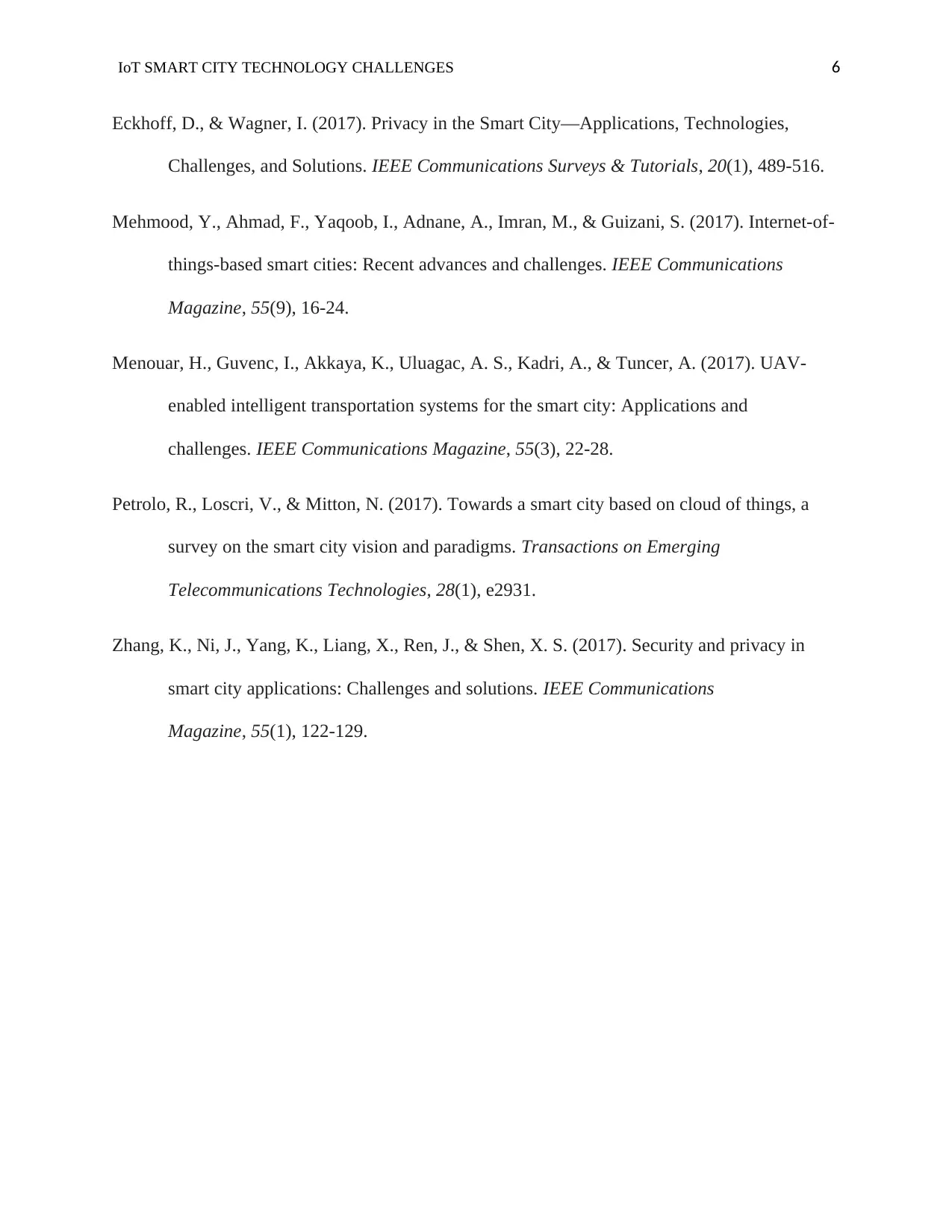
IoT SMART CITY TECHNOLOGY CHALLENGES 6
Eckhoff, D., & Wagner, I. (2017). Privacy in the Smart City—Applications, Technologies,
Challenges, and Solutions. IEEE Communications Surveys & Tutorials, 20(1), 489-516.
Mehmood, Y., Ahmad, F., Yaqoob, I., Adnane, A., Imran, M., & Guizani, S. (2017). Internet-of-
things-based smart cities: Recent advances and challenges. IEEE Communications
Magazine, 55(9), 16-24.
Menouar, H., Guvenc, I., Akkaya, K., Uluagac, A. S., Kadri, A., & Tuncer, A. (2017). UAV-
enabled intelligent transportation systems for the smart city: Applications and
challenges. IEEE Communications Magazine, 55(3), 22-28.
Petrolo, R., Loscri, V., & Mitton, N. (2017). Towards a smart city based on cloud of things, a
survey on the smart city vision and paradigms. Transactions on Emerging
Telecommunications Technologies, 28(1), e2931.
Zhang, K., Ni, J., Yang, K., Liang, X., Ren, J., & Shen, X. S. (2017). Security and privacy in
smart city applications: Challenges and solutions. IEEE Communications
Magazine, 55(1), 122-129.
Eckhoff, D., & Wagner, I. (2017). Privacy in the Smart City—Applications, Technologies,
Challenges, and Solutions. IEEE Communications Surveys & Tutorials, 20(1), 489-516.
Mehmood, Y., Ahmad, F., Yaqoob, I., Adnane, A., Imran, M., & Guizani, S. (2017). Internet-of-
things-based smart cities: Recent advances and challenges. IEEE Communications
Magazine, 55(9), 16-24.
Menouar, H., Guvenc, I., Akkaya, K., Uluagac, A. S., Kadri, A., & Tuncer, A. (2017). UAV-
enabled intelligent transportation systems for the smart city: Applications and
challenges. IEEE Communications Magazine, 55(3), 22-28.
Petrolo, R., Loscri, V., & Mitton, N. (2017). Towards a smart city based on cloud of things, a
survey on the smart city vision and paradigms. Transactions on Emerging
Telecommunications Technologies, 28(1), e2931.
Zhang, K., Ni, J., Yang, K., Liang, X., Ren, J., & Shen, X. S. (2017). Security and privacy in
smart city applications: Challenges and solutions. IEEE Communications
Magazine, 55(1), 122-129.
⊘ This is a preview!⊘
Do you want full access?
Subscribe today to unlock all pages.

Trusted by 1+ million students worldwide
1 out of 6
Related Documents
Your All-in-One AI-Powered Toolkit for Academic Success.
+13062052269
info@desklib.com
Available 24*7 on WhatsApp / Email
![[object Object]](/_next/static/media/star-bottom.7253800d.svg)
Unlock your academic potential
Copyright © 2020–2025 A2Z Services. All Rights Reserved. Developed and managed by ZUCOL.




